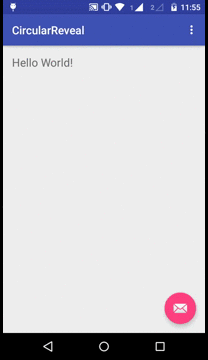I am currently creating an Android app where someone can input their name, press a button, and then it just outputs their name back to them.
One effect that I would like to achieve with this is an effect where, after they push the button, the input and button will vanish (complete this bit so far), and then the background colour of the MainActivity's view will do a ripple (from the centre) with a new colour, eventually changing the full background colour.
How would I go about doing this programatically, since I am only able to find tutorials on adding ripples to buttons when pushed?
EDIT:
I tested this by making a small app
First of all hide the view you want to reveal in this animation.
The view can be from the same layout and in xml its visibility should be invisible so that the animation will reveal it.
You can set the view height and width to match parent if you want to create a full screen animation...
Take your original and reveal view both in frame layout
In my case,I have used this:
<FrameLayout
android:layout_width="match_parent"
android:layout_height="match_parent">
<TextView android:text="Hello World!"
android:layout_width="wrap_content"
android:textSize="20sp"
android:layout_height="wrap_content" />
<LinearLayout
xmlns:android="http://schemas.android.com/apk/res/android"
android:orientation="vertical" android:layout_width="match_parent"
android:layout_height="match_parent"
android:background="@color/colorPrimaryDark"
android:id="@+id/revealiew"
android:visibility="invisible"
>
</FrameLayout>
then in your activity on button click or some event do this:
fab.setOnClickListener(new View.OnClickListener() {
@TargetApi(Build.VERSION_CODES.LOLLIPOP)
@Override
public void onClick(View view) {
// previously invisible view
View myView = findViewById(R.id.revealview);
// get the center for the clipping circle
int cx = myView.getWidth() / 2;
int cy = myView.getHeight() / 2;
// get the final radius for the clipping circle
int finalRadius = Math.max(myView.getWidth(), myView.getHeight());
// create the animator for this view (the start radius is zero)
Animator anim =
ViewAnimationUtils.createCircularReveal(myView, cx, cy, 0, finalRadius);
//Interpolator for giving effect to animation
anim.setInterpolator(new AccelerateDecelerateInterpolator());
// Duration of the animation
anim.setDuration(1000);
// make the view visible and start the animation
myView.setVisibility(View.VISIBLE);
anim.start();
}
});
}

You can take detailed look at official documentation here: http://developer.android.com/training/material/animations.html
What you are describing is a reveal effect on the background.
From the official doc you can find ready to use examples:
1) Here is how to reveal a previously invisible view using reveal effect:
// previously invisible view
View myView = findViewById(R.id.my_view);
// get the center for the clipping circle
int cx = myView.getWidth() / 2;
int cy = myView.getHeight() / 2;
// get the final radius for the clipping circle
int finalRadius = Math.max(myView.getWidth(), myView.getHeight());
// create the animator for this view (the start radius is zero)
Animator anim =
ViewAnimationUtils.createCircularReveal(myView, cx, cy, 0, finalRadius);
// make the view visible and start the animation
myView.setVisibility(View.VISIBLE);
anim.start();
2) Here is how to hide a previously visible view using the reveal effect:
// previously visible view
final View myView = findViewById(R.id.my_view);
// get the center for the clipping circle
int cx = myView.getWidth() / 2;
int cy = myView.getHeight() / 2;
// get the initial radius for the clipping circle
int initialRadius = myView.getWidth();
// create the animation (the final radius is zero)
Animator anim =
ViewAnimationUtils.createCircularReveal(myView, cx, cy, initialRadius, 0);
// make the view invisible when the animation is done
anim.addListener(new AnimatorListenerAdapter() {
@Override
public void onAnimationEnd(Animator animation) {
super.onAnimationEnd(animation);
myView.setVisibility(View.INVISIBLE);
}
});
// start the animation
anim.start();
In you app, you can use a colored background layer (invisible at the beginning) and then use the reveal effect on it.
If you love us? You can donate to us via Paypal or buy me a coffee so we can maintain and grow! Thank you!
Donate Us With